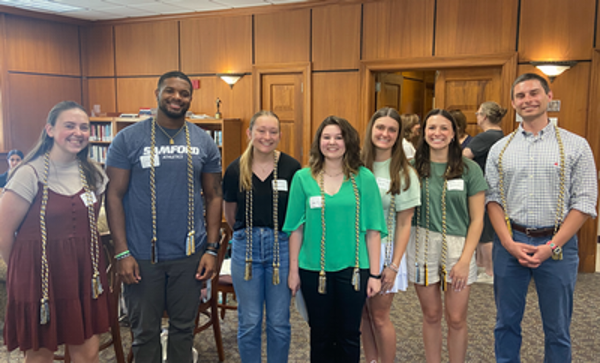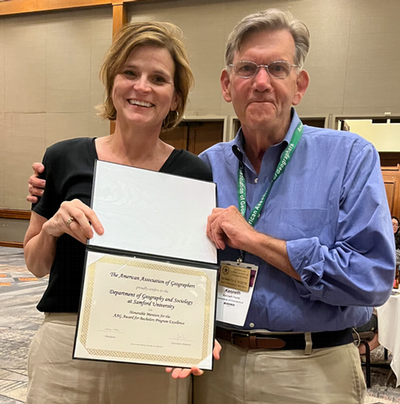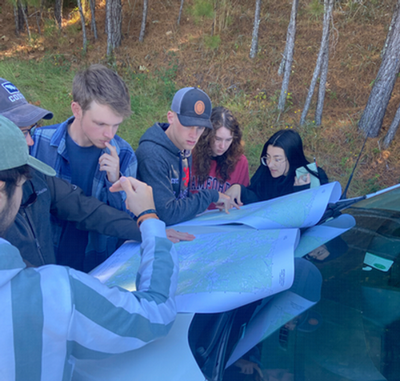
In April, Samford University’s Geography and Sociology department earned an honorable mention in the 2024 American Association of Geographers (AAG) Award for Bachelor’s Program Excellence. This national recognition underscores the department's continued commitment to academic excellence, faculty leadership and student success, while paving the way for future growth through innovative programs and meaningful community engagement.
“For a department of our size at a liberal arts university like Samford, receiving this award from the AAG—our discipline’s premier organization—is a remarkable accomplishment,” said Jennifer Speights-Binet, professor and department chair of Geography and Sociology. “The award committee specifically acknowledged our ability to leverage unforeseen changes like restructuring and post-COVID pressures as opportunities to innovate and create interdisciplinary connections.”

Since its merger with the Sociology department in 2018, the Geography program at Samford has continued to thrive, offering two distinct paths: the Bachelor of Science in Geography and the Bachelor of Science in Geography with a geographic information systems (GIS) concentration. Additionally, the department provides three minors, including environmental studies, traditional geography and race, ethnicity and social justice, as well as a GIS certificate for non-majors. The department has made impressive strides in both enrollment and curriculum development, reflecting the ever-growing importance of geography in today’s academic and professional landscapes.
In recent years, faculty efforts have led to a 300% increase in introductory GIS course enrollment and significant growth in upper-level GIS courses. This expansion speaks to the department’s ability to adapt and evolve in response to the increasing demand for GIS education, a field that continues to shape industries and research worldwide. Most GIS students have multiple job offers when they graduate from Samford.
At the heart of the department's success is a dedicated faculty committed to innovation and collaboration. Geography faculty members have earned prestigious teaching awards, and their work garnered attention for its contributions to student success both inside and outside the classroom.
“It is invigorating to be part of a department that strives every day for excellence in teaching,” said Jordan Cissell, assistant professor of Geography and Sociology. “Collaboration is central to our approach, with students participating in award-winning research and peer tutoring in GIS. Regular field trips and social events foster a tight-knit community, which I believe is one of our greatest strengths.

Graduates are making an impact locally and globally. Recent alumni have pursued advanced degrees at institutions such as the University of Georgia and the University of Illinois Chicago, while others launched successful careers in industries ranging from public health to environmental conservation. Students are gaining real-world experience through internships with organizations including the U.S. Forest Service and the Cahaba Riverkeeper, ensuring they are well prepared for diverse career paths.
Sarah Grumulaitis, a 2020 graduate of Samford’s Geography program, now works in urban planning at Arup, a global design and engineering firm.
“My time in Samford’s geography program was transformative, laying a strong foundation in urban environments, sustainability and GIS," said Grumulaitis. "It shaped my approach to problem-solving at Arup, while Dr. Speights-Binet’s Urban Geography course in Rome remains a cherished experience that deepened my understanding of cultural context in planning.”
Beyond the classroom, the department has demonstrated an ongoing commitment to engaging with the broader community. Faculty and students have been involved in a wide array of research projects and service initiatives, from creating a COVID-19 county-level data dashboard to assisting with conservation efforts in the Dutch Caribbean and Belize. Students with geography degrees are marketable in careers such as environmental sciences, management, urban planning, conservation work and geospatial analysis in the business, governmental and nonprofit sectors.
As the department continues to grow, Samford Geography and Sociology remains dedicated to fostering an inclusive, collaborative environment that prepares students for success in an increasingly interconnected world. With their recent recognition from the AAG, the department's faculty and students are eager to continue strengthening geography programs at Samford.
Learn more about careers in geography on the American Association of Geographer’s website.
